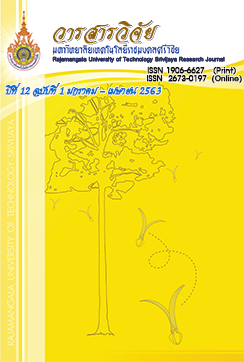The Study of Killing Process, Dissection, and Carcass Quality of Goats Meat in Krabi Province
Keywords:
killing process, dissection, carcass quality, Krabi ProvinceAbstract
The purpose of this study was to examine the killing process, dissection and carcass quality of meat goats in Krabi Province including 20 of male bore-anglo-nubians with the age of 4, 6, 7, 8 and 9 months, and 8 of male local native goats with 2 and 4 years old. There are 4 slaughterhouses in Krabi Province where the killing process and goat meal samples were collected for studying. The killing process of these 4 slaughterhouses are performed by cutting the throat of the goat for getting rid of blood, taking out the offal, using fire to burn the goat hair, and trimming the carcass in response to the consumers’ needs. Regarding the goat meat consumption in Krabi Province, customers prefer to consume goat meat with bone by cutting offal and genital organs together for sale. After the killing process, one goat carcass lost about 10 percentage of its weight. Goats slaughtered at the age of 4-9 months weighed around 20-29 kilograms. The weight loss from the process was about 10 percent and the pH value of goat was 6.55 after 1 hour killing and 6.05 after soaking the carcass at the temperature of 3 Cº for 24 hours. The cost of cutting meat and cutting force is higher with the older goat. The nutritional values of protein and fat in meat are 50.78-75.00 and 4.70-13.48 percent, respectively.
References
ชัยณรงค์ คันธพนิต. 2529. วิทยาศาสตร์เนื้อสัตว์. ไทยวัฒนาพานิช จำกัด, กรุงเทพฯ.
ชูตา แก้วละเอียด. 2558. รายงานการวิจัย การพัฒนาการตลาดแพะเพื่อเพิ่มมูลค่าทางเศรษฐกิจ ของเกษตรกรผู้เลี้ยงแพะในจังหวัดสงขลา. สำนักงานเศรษฐกิจการเกษตร.
วุฒิชัย สีเผือก, วันวิศาข์ งามผ่องใส และ ไชยวรรณ วัฒนจันทร์. 2562. การใช้ทางใบปาล์มน้ำมันร่วมกับกากตะกอนปาล์มน้ำมันในอาหารสำเร็จต่อสมรรถภาพการให้ผลผลิตของแพะขุน. วารสารมหาวิทยาลัยนราธิวาสราชนครินทร์ 11(3): 190-201.
สมนึก ลิ้มเจริญ, มงคล คงเสน, ประจักษ์ เทพคุณ, จำนงค์ จุลเอียด และ ฮาลีหม๊ะ ดือราโอ๊ะ. 2562. แนวทางการส่งเสริมการบริโภคเนื้อแพะในจังหวัดนราธิวาส. วารสารแก่นเกษตร 47 ฉบับพิเศษ(1): 999-1008.
AOAC. 2001. Official Methods of Analysis (18thed.). The Association of Official Analytical Chemists, Washington DC.
Babiker, I.A., Khider, E.l. and Shafie, S.A. 1990. Chemical composition and quality attributes of goat meat and lamb. Meat Science 28(4): 273-277.
Dhanda, J.S., Taylor, D.G. and Murray. P.J. 2003. Part 1. Growth carcass and meat quality parameters of male goats: effects of genotype and liveweight at slaughter. Small Ruminant Research 50(1-2): 57-66.
Gaffar, M.A. and Biabani, S.Z. 1986. Effect of plane of nutrition on carcass characteristics, body composition and nutrient deposition in Osmanababi goats. Indian Journal of Animal Nutrition 3(3): 173-178.
Gaili, E.S. and Ali, A.E. 1985. Meat from Sudan Desert sheep and goats: Part 1.- Carcass yield, Offals distribution of carcass tissues. Meat Science 13(4): 217-227.
Sebsibe, A.N.H, Casey, W.A, Van, N.A. and Coertze, R.J. 2007. Growth performance and carcass characteristics of three Ethiopian goat breeds fed grainless diets varying in concentrate to roughage ratios. South African Jornal of Animal Science 37(4): 221-232.
Steel, R.G.D. and Torrie, J.H. 1980. Principles and Procedures of Statistics: A Biometrical Approach (2nd edition). McGraw-Hill, New York.
Downloads
Published
How to Cite
Issue
Section
License
The content and information in the article published in Journal of Rajamangala University of Technology Srivijaya It is the opinion and responsibility of the author of the article. The editorial journals do not need to agree. Or share any responsibility.







